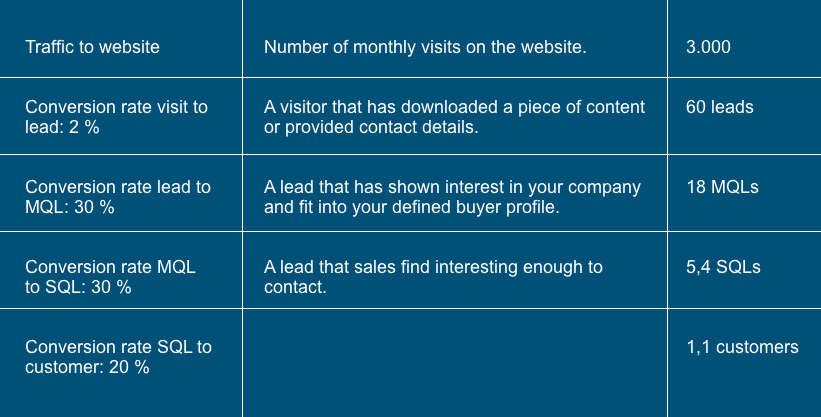Profitability and growth: How to set smart goals and how to reach them
Having specific, measurable, time-based, attainable and relevant company goals are one thing – but are you reaching them? Here’s how to set good business goals and how to reach them.
Successful businesses always has this one thing in common: they are based on both goals and objectives. Why? Because this helps clarify the very purpose of the business and makes it easier to identify necessary actions to take in order to achieve success.
The goals should be the desired outcome, such as profitability and growth, whilst objectives are the specific steps your company need to take in order to reach the goals. Having smart goals can help your business grow, help everyone understand the direction your business is heading in and improve collaboration.
To increase the chances of actually reaching the company goals, you should set goals that are smart. But what are smart goals and how do you reach them?
How to set smart goals for your company 
A smart goal should be the following: Specific, measurable, attainable, relevant and time-based.
This helps you identify what the exact goals are, at what time these should be reached and identify specific actions to move towards those goals.
Both goals and objectives should be smart. So how do you set smart goals?
Begin by writing down the overall goal. Say you are investing in a new marketing strategy and want the annual revenue generated by this to be 132,000 NOK (13,716 EUR).
Then split this into goals the marketing and sales department can relate to. In order to find out how many customers from this marketing strategy your company needs to close each month to get this annual revenue, you’ll have to look at the total revenue for a customer.
Based on this, you can count backwards to break the overall goal down to more attainable marketing and sales goals. If the total revenue for a customer is 10,000 NOK (1039 EUR), you’ll need to get 1,1 customers each month to reach the annual revenue goal.
If the conversion rate from SQL (sales qualified lead) to customer is 20 %, your company needs 5,4 SQLs each month. Moreover, if the conversion rate from MQL (marketing qualified lead) to SQL is 30 %, you’ll need 18 MQLs each month.
Continue to break this down into leads, visitors and website traffic and you’ll get a marketing department that not only feels ownership of the company’s profitability goals but are also much more likely to reach their goals.

Want to learn more about how you break the overall company goals into more specific goals for the marketing department? Watch this video where we go through the entire calculation, from how many customers your sales department has to close each month to how much website traffic the marketing department has to attract monthly.
Remember to always set a deadline for when these goals should be met and identify the biggest challenges that might make reaching the goals difficult so that your company can tackle them straight away.
How to reach the goals
It doesn’t matter much that you have great goals if your company isn’t able to reach them. One thing is stretch goals – which we are huge fans of – but unrealistic goals is another thing.
That’s why you need to set smart goals, to make it easier for everyone in the company to contribute to reaching the overall profitability goal. Here are three specific things you can do:
1. Make everyone in the company feel ownership to the goals
Make it clear to everyone in the company what is the desired outcome, what you expect from the actions being taken and how you’ll know that the goal has been achieved.
Then, the second important step is to make it clear what you expect from your colleagues. Break down the overall company goal into smaller, more attainable goals for each department to reach. If you can, write down who is responsible for achieving specific steps, this can be either individuals or departments.
This will help your colleagues feel ownership of the goal because they know exactly how they are contributing to the result. Also, it will make it easier for everyone to see how far you’ve come towards reaching the overall goal and where you’ll need to make adjustments and improvements.
2. Stick to the goals but feel free to adjust them along the way
You’ll set your goals based on metrics and results your company already have. It might also be beneficial to look at industry benchmarks, especially if you’re starting from scratch and don’t have any previous results to base the goals on.
However, keep in mind that the goals won’t be perfect at first try. You will, most likely, at some point either crush them or lag far behind – and that’s okay. Adjust them along the way and bring in relevant people in the company to discuss the goals again if they don’t seem to be right.
When setting the goals you should spend time describing the actions your company is going to take in detail and how much time your colleagues should spend on these actions. This will make it easier for everyone to stick to the goals that should be met.
3. If your company aren’t seeing the results you want: Don’t be afraid to try out a new strategy
Are you far away from reaching the overall goals? Are your company processes up to date? Is there any room for improvement (the answer here, by the way, is always yes)?
There are always things that can be improved or made more efficient. It might sound cheesy but it’s as simple as this: If things don’t go your way – try something new. Pinpoint the weak spots and start from there.
Is the collaboration between the marketing and sales department too poor to reach the customer goals? Implement new routines that will better the collaboration, for example by using a Sales Level Agreement (SLA) and making the two departments agree upon what kinds of leads the company needs and what qualifies these. Or change the marketing strategy – it’s as simple as that.
Read more: How to get a more profitable marketing and sales department
Having goals that are specific, measurable, time-based, attainable and relevant is crucial to your company’s success. This will not only make it easier to actually reach the goals, it will also make sure that everyone in the company feels ownership of the overall goal – meaning that they are more likely to work hard to reach it with their specific contributions.
To reach the goals, you’ll sometimes have to change strategy. Perhaps it’s time for a new marketing strategy to make sure that your company attracts enough leads for the sales department to close enough customers?
Take our test to find out if inbound marketing may be your solution to reaching the company goals.
Real Growth. Real Impact.
HubSpot for startups: Leveraging the platform and unlocking growth w. Ragini Campion
Making AI adoption not a big deal with Mike Kaput from The AI Show
HubSpot's Spring Spotlight 2025 was not what we expected
The Power of Community in Marketing
The Return of Human Marketing in an Automated Age | Avidly Talks
How to make change projects a success - Change management tactics
How to prompt AI for great creative ideas
See why enterprises choose Avidly
Let’s build your HubSpot success story
Compelling final call to action - with accompanying link to Contact page

![[TEST]: How well does inbound marketing fit your company?](https://no-cache.hubspot.com/cta/default/308131/5dc8cd11-970b-4f27-a429-290b28a64aa5.png)







